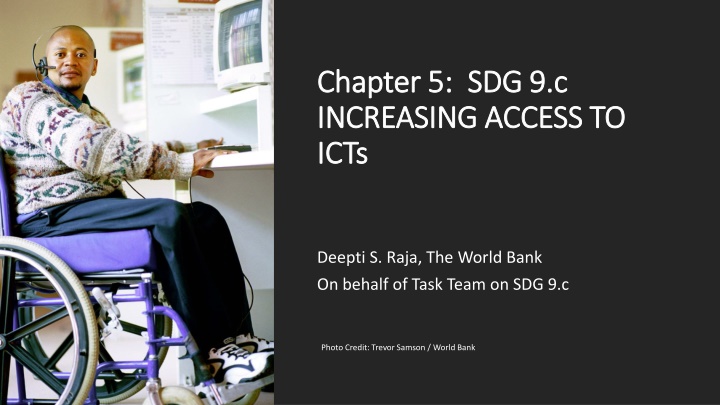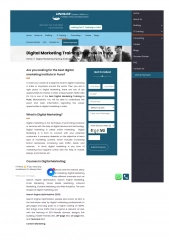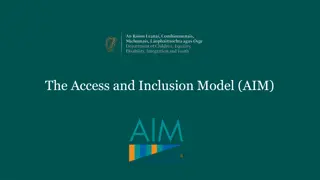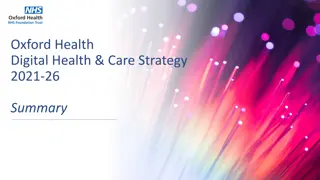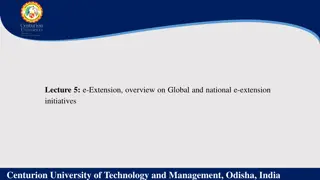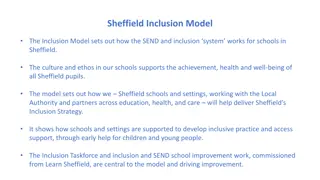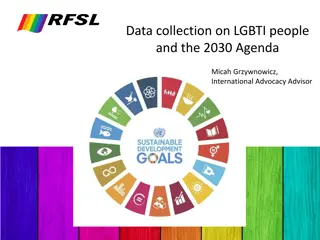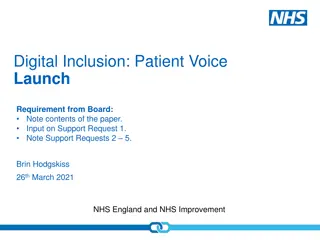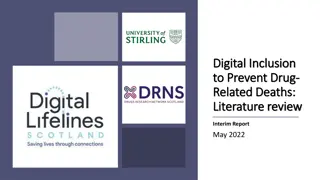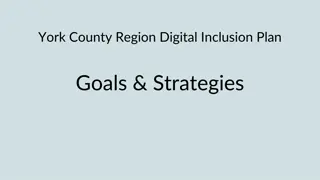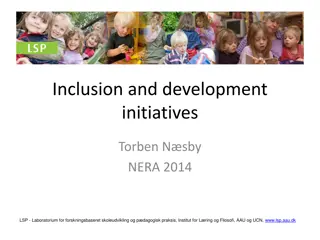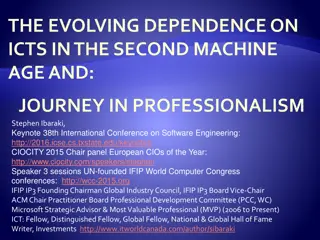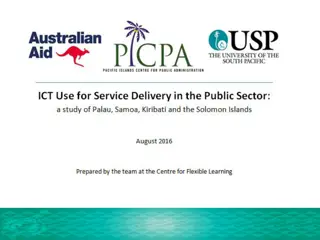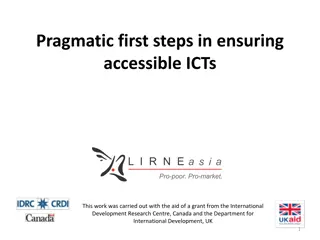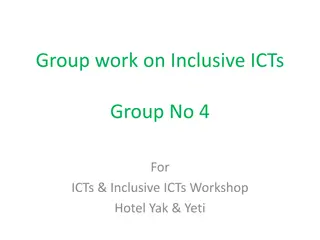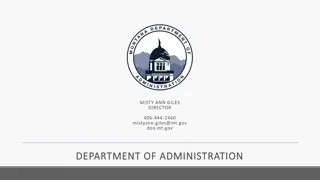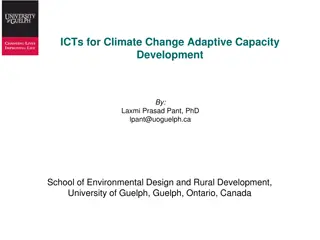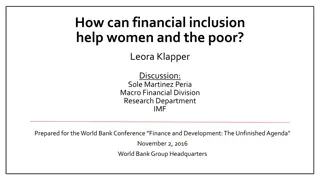Increasing Access to ICTs for Digital Inclusion
For most people, technology makes things easier. However, for persons with disabilities, technology makes things possible. Explore how ICT is increasing access and promoting digital inclusion, focusing on SDG 9.c. Learn about initiatives, research, and discussions shaping the landscape of internet access and technology adaptation for all. Join the conversation on universal and affordable internet access, training needs, and cross-linkages across various sectors.
Download Presentation

Please find below an Image/Link to download the presentation.
The content on the website is provided AS IS for your information and personal use only. It may not be sold, licensed, or shared on other websites without obtaining consent from the author.If you encounter any issues during the download, it is possible that the publisher has removed the file from their server.
You are allowed to download the files provided on this website for personal or commercial use, subject to the condition that they are used lawfully. All files are the property of their respective owners.
The content on the website is provided AS IS for your information and personal use only. It may not be sold, licensed, or shared on other websites without obtaining consent from the author.
E N D
Presentation Transcript
Chapter 5: SDG 9.c Chapter 5: SDG 9.c INCREASING ACCESS TO INCREASING ACCESS TO ICTs ICTs Deepti S. Raja, The World Bank On behalf of Task Team on SDG 9.c Photo Credit: Trevor Samson / World Bank
Martin Gould, G3ICT Stuart Hamilton, Independent Expert Derrick L. Cogburn, Institute of Disability and Public Policy, American University (Coordinator) Nancy Bolt, International Federation of Library Associations Stephen Wyber, International Federation of Library Associations Jose Maria Batanero, ITU Heidi Ullmann, UN ECLAC Task Team Task Team Members Members Irmgarda Kasinskaite-Buddeberg, UNESCO Florence Migeon, UNESCO Deepti Samant Raja, The World Bank (Coordinator)
Collating research reports and publications authored or recommended by task team members Original research conducted by some members such as UN ECLAC, IFLA What did we What did we do? do? UNESCO commissioned a detailed desk review Over 50 references
The mandate The mandate SDG 9: Industry, Innovation and Infrastructure Reference to Internet access represents a crucial factor in the development of digital inclusion Target 9.C: Significantly increase access to information and communications technology and strive to provide universal and affordable access to the Internet in least developed countries by 2020 Main issues: Broadband to get to the Internet/web Access to technology Adaptations to the technology depending on the specific disability and needs Training in use and application where needed
Discussion Questions Discussion Questions Cross-linkages across chapters this chapter stays focused on 9c with some but not extensive references to how ICT plays a role in education, employment, independent living etc. Level of detail, data and coverage of issues General v. specific recommendations Other comments and observations
INTRODUCTION INTRODUCTION
Framing the topic of digital inclusion For most people, technology makes things easier. For persons with disabilities, technology makes things possible. Mary Pat Radabaugh, former Director of the IBM National Support Centre for Persons with Disabilities ICT increasingly used for service delivery, access to information Mainstream ICTs are increasingly accessible with a range of assistive features Access to internet seen as human right Increasing potential for ICT to be an equalizer
Value of inclusive ICTs for participation Value of inclusive ICTs for participation Rankings by 150 experts from 55 countries for the importance of different ICTs for inclusion (UNESCO et al., 2013). Scale: 5 = Most important,1 = Least important. Websites 3.3* 3.0* 3.4* 3.7* 3.7* 3.4 3.5* 3.3* Mobiles 3.1 2.6 3.0 3.4 3.3 4.6* 3.0 3.1 TV sets 2.9 2.8 2.7 2.9 2.5 2.8 3.0 2.7 Radio 2.5 2.3 2.3 2.4 2.2 2.4 2.3 2.5 Other 2.7 2.9 2.8 2.8 2.7 2.8 2.6 2.6 Healthcare Primary education Secondary education Tertiary, prof., lifelong education Employment Independent living Government services Participation: Political/public life Websites and mobile devices and services can contribute most to inclusion Highest impact on independent living, employment, education, and access to government services
INTERNATIONAL NORMATIVE FRAMEWORK INTERNATIONAL NORMATIVE FRAMEWORK
Convention on the Rights of Persons with Convention on the Rights of Persons with Disabilities Disabilities Accessibility is a core principle; 7 articles with Accessibility Dispositions with implications for ICTs (G3ict ICT Progress Report 2016) Article 9: ensure access to information and communications technologies and systems; technology design should take into account accessibility and usability Article 21: access to information Article 24: access to technology to support or assist learning Article 26: promote the availability, knowledge and use of assistive devices and technologies
Sustainable Development Goals Sustainable Development Goals SDG 9: Industry, Innovation and Infrastructure Reference to Internet access represents a crucial factor in the development of digital inclusion Target 9.C: Significantly increase access to information and communications technology and strive to provide universal and affordable access to the Internet in least developed countries by 2020 SDG 16: Peace, Justice and Strong Institutions Reference to e-government services, electoral processes, access to information SDG 17: Partnerships for the goals Collaborative development of technology, technology transfer, capacity building
Other global and regional treaties Other global and regional treaties WSIS+10 Review and Strategic Directions for Building Inclusive Knowledge Societies for Persons with Disabilities Article 12 of the International Telecommunication Regulations Tunis Commitment of 2005 European Union Digital Agenda (2010) European Accessibility Act (2016) New Urban Agenda (2016) 2013 Marrakesh VIP Treaty
SITUATION OF PERSONS WITH DISABILITIES SITUATION OF PERSONS WITH DISABILITIES
Disability and the Digital Divide Disability and the Digital Divide Lack of globally comparable data on Internet access/usage by persons with disabilities Overall, ICT data shows a divide between developed and developing regions, as well as a gender divide Recent study in Great Britain found that persons with disabilities were more than 20% less likely to have ever used the internet than those without a disability (UK Office for National Statistics, 2013) Global data shows that mobile cellular networks and 3G coverage are increasing in demand over fixed broadband networks
Latin America and the Caribbean (11 countries): use of internet by disability status, around 2010 Latin America and the Caribbean (11 countries): use of internet by disability status, around 2010 (In percentages) Source: Ullmann, Jones, Williams and Williams (ECLAC), forthcoming 2018. Do not copy or reproduce without author permission.
Latin America and the Caribbean (11 countries): use of and access to the internet by persons with disability by Latin America and the Caribbean (11 countries): use of and access to the internet by persons with disability by age, around 2010 age, around 2010 Source: Ullmann, Jones, Williams and Williams (ECLAC), forthcoming 2018. Do not copy or reproduce without author permission.
Meeting CRPD ICT Obligations Meeting CRPD ICT Obligations G3ict & DPI 2016 ICT Accessibility Progress Report Overall Degree of Compliance with CRPD ICT Accessibility Provisions Countries in the Global South Survey Data Clusters All countries 42% Leg 1 - Countries' Commitments 33% Leg 2 - Countries' Capacity for Implementation 21% 18% Leg 3 - Countries' Implementation and Impact 41% 35% Degree of Compliance of Country Legislations and Policies with CRPD ICT Accessibility Provisions Policies Covering Accessibility for Specific ICT Products or Services Policies Covering Specific Application Areas Policies Covering Specific Target Groups Policies to Promote Accessible and Assistive ICTs General Regulatory Framework 69% 45% 27% 17% 16% All countries 57% 34% 21% 15% 11% Countries in the Global South
Meeting CRPD ICT Obligations Meeting CRPD ICT Obligations G3ict & DPI 2016 ICT Accessibility Progress Report Degree of Country Capacity to Implement CRPD ICT Accessibility Provisions Government Focus Support of DPOs and NGOs Capacity building 35% 31% 10% 8% 22% 18% All countries Countries in the Global South Degree of Implementation CRPD ICT Accessibility Provisions and Impact Telecom and Media Services and Computers Mobile Special Services 41% 45% 33% All countries 36% 41% 24% Countries in the Global South
2016 United Nations E 2016 United Nations E- -Government Survey Government Survey Shows positive trend towards investments and efforts by countries to ensure outreach of online services to different marginalized groups Significant jumps in the number of countries that have invested in targeted efforts to reach out to youth, women, and immigrants. However, while there have been increases from the last survey, only 13 countries introduced services between 2014 and 2016 for older persons and persons with disabilities. As a result, the total number of countries offering such service is less than one-third of all countries (193)
GOOD PRACTICES AND POLICY TRENDS GOOD PRACTICES AND POLICY TRENDS
Policy Trends Policy Trends Public Procurement & Accessibility Standards Inclusion of accessibility requirements in public procurement of ICT/electronic equipment is an important policy tool Tie procurement requirements to accessibility standards and guidelines for accessible websites, documents, other digital media Section 508 in the US and Europe s EN 301 549 are the main models The implementation of Section 508 led to greater innovation, competition, and choice for accessible technology in the marketplace (G3ict 2015) Web Content Accessibility Guidelines 2.0; ISO accessibility standards for a variety of ICTs such as keyboards & screens, software, PDF documents; digital publishing guidelines; and standards for closed captioning and digital video broadcasting
Policy Trends Policy Trends National level policies and programs Trends from G3ict & DPI 2016 ICT Accessibility Report Captioning or signing of television programs implemented by 50% of the countries; Relay services for deaf and speech impaired users (implemented by 23% of the countries); Implementation of computer-based Assistive Technologies in schools and universities (31% of the countries have some level of implementation); A government body dedicated to ICTs (implemented by 54% of the countries); and Libraries for the blind or public libraries with e-book services (implemented by 36% of the countries).
Laws, regulations and policies enacted by States Parties by Level of Implementation - Does the Country: No Implementation Minimum Level Partial Level Substantial Level Full Level Ensure that government communications to the public using ICTs are provided in accessible formats, sign language or Braille? 53% 32% 12% 2% 0% Define public procurement rules policy promoting accessible ICTs? Have policies for ATs and Services by Type of Disability: Blind? Have policies for ATs and services by Type of Disability: Visually Impaired? Have policies for ATs and Services by Type of Disability: Deaf? Have policies for ATs and Services by Type of Disability: Hearing Impaired? Have policies for ATs and Services by Type of Disability: Reduced Mobility? Have policies for ATs and Services by Type of Disability: Cognitive? Have laws, policies or programs to ensure that PwD and their representative organizations are consulted in development and implementation of legislation? 69% 20% 8% 2% 0% 32% 40% 17% 10% 0% 31% 40% 19% 8% 1% 31% 38% 20% 11% 0% 32% 38% 21% 10% 0% 33% 28% 27% 10% 1% 42% 42% 15% 0% 1% 34% 41% 16% 7% 2% Source: 2016 ICT Accessibility Progress Report
Specific Application Areas by Level of Implementation No Minimum Partial Substantial Full Emergency Response Services 66% 22% 7% 3% 2% Primary and Secondary Education Higher Education Rehabilitation Services Health Services Electronic Kiosks Judicial Information and Legal Procedure Independent Living Reasonable Accommodation at Workplace 51% 13% 30% 5% 1% 58% 54% 65% 82% 71% 18% 20% 20% 13% 18% 17% 21% 14% 4% 10% 6% 4% 1% 0% 1% 1% 1% 0% 1% 0% 65% 58% 19% 25% 13% 10% 2% 7% 1% 0% Teleworking Smart Cities 86% 80% 14% 20% 0% 0% 0% 0% 0% 0% Source: 2016 ICT Accessibility Progress Report
Practice Trends Practice Trends Universal Design and built-in accessibility in mainstream ICT Internet based assistive technologies Specialized assistive technologies Accessible and assistive mobile apps Webtools and online platforms Potential for inclusive home and external environments through Internet of Things Accessible television and radio
UN ACTIVITIES UN ACTIVITIES
WHO UNESCO UNICEF ITU ILO World Bank UN Activities UN Activities
RECOMMENDATIONS AND CONCLUSION RECOMMENDATIONS AND CONCLUSION
Recommendations Recommendations Take an ecosystem approach to promoting accessible and inclusive ICTs Promote the visibility and understanding of disability Raise awareness and knowledge of ICT accessibility Build capacity of governments, practitioners, technology developers, designers, educators, librarians, others Involve persons with disabilities directly Collect/publish comparable data at the national level Improve the legislative and regulatory framework
Recommendations Recommendations Provide affordable Internet access for persons with disabilities Reduce cost and access barriers for mobile and assistive technologies Promote indigenous, local language ICT solutions Promote the principles of Universal Design in the mainstream ICT industry and the public sector Provide funding mechanisms to support the development of open-source software Promote ICT-based vocational training and higher education of persons with disabilities Create dedicated national government departments/focal points for ICT Accessibility Create an international pool of experts in the field of ICT accessibility
Conclusion Conclusion To maximize the social and economic dividends of digital technologies we have to pay attention to the analog complements such as policy and regulations, skills and capacity, and institutional accountability (The World Bank, 2016) Digital technologies present an unprecedented opportunity for inclusion; but also a risk of further exclusion and disenfranchisement Implementation of recommendations needs the involvement of multiple stakeholders Availability, affordability, and access to inclusive ICTs is key There is a need for increased funding and investment Mainstream accessibility and inclusion in general ICT for development projects
Discussion Questions Discussion Questions Cross-linkages across chapters this chapter stays focused on 9c with some but not extensive references to how ICT plays a role in education, employment, independent living etc. Level of detail, data and coverage of issues General v. specific recommendations Other comments and observations
Reach out to us Reach out to us Deepti Raja draja@worldbank.org Derrick Cogburn dcogburn@idppglobal.org
